History of Rowing Victoria Inc
- Table of Contents
- Introduction
- Chapters
- 1: Rowing in a young Victoria 1838-1859
- 2: Formation of the Association 1860-1875
- 3: Growth of the Sport 1876-1889
- 4: Years of great success 1890-1899
- 5: The rise of Australian Henley1900-1909
- 6: The War Years 1910-1919
- 7: Women's rowing and the modern era 1920-1929
- 8: The Depression Rebuild 1930-1939
- 9: War and rebuilding 1940-1949
- 10: Expansion years 1950-1959
- 11: The search for international success 1960-1969
- 12: Combining the Associations and lightweight success 1970-1979
- 13: The new national program 1980-1989
- 14: Golden years 1990-1999
- 15: Professionalism 2000-2009
- 16: Yet More Growth 2010-2019
- 17: Challenging Times 2020-2026
- Appendices
- 1: Life Membership and other important awards
- 2: Patrons and Presidents
- 3: Office Bearers
- 4: Clubs and their histories
- 5: The Oarsmen's Centotaph and WWI Roll of Honour
- 6: WWII Roll of Honour
- 7: Premierships
- 8: State Championships
- 9: Hall of Fame Inductees
- 10: Victorian Olympians
- 11: International representation
- 12: Intercolonial and Interstate Racing
- 13: School rowing
- 14: University rowing
- 15: Histories of Victorian Rowing
- 16: Annual Reports
4. Years of Great Success (1890-1899)
Chapter 4 page 1 2 3 4
This page is under construction
Much of the information used in this decade comes from the annual reports of the Association which can be found in appendix 16. This chapter was compiled by Dominic Frederico and Andrew Guerin.
The 1890s were filled with much distress for Victorians with a depression which followed the 1880s property boom. The result was a collapse in private investment, urban development and a pullback on public infrastructure investment. Banks failed, property prices fell and farmers struggled through severe drought. And to top all this off, the 1891 Yarra River floods were severe and eclipsed the flood of 20 years earlier and the 1898 Gippsland bush fires were severe.
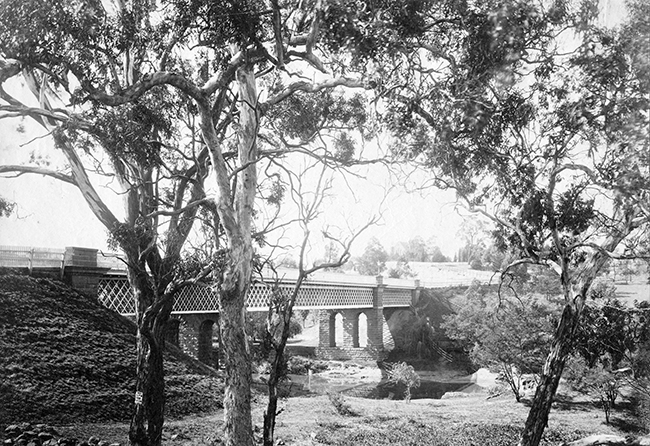
The Hawthorn Bridge (built 1861) in about 1890
Photo from the Guerin collection
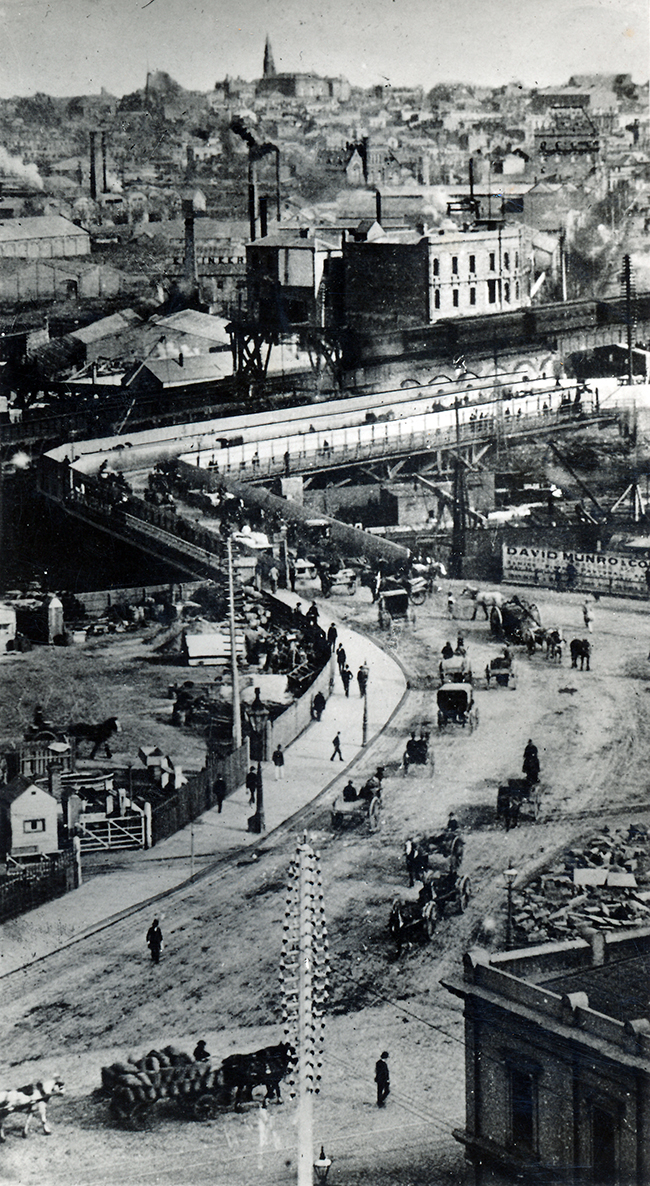
The Falls Bridge in about 1890 looking towards the city
Photo from the Lindblade collection of Mercantile Rowing Club
1889-1890 season
Photo from the Lindblade collection of Mercantile Rowing Club
The 1890 annual meeting of the Victorian Rowing Association (VRA) marked a significant milestone, with one of the best attendances in years. The hon. secretary, Mr. W. B. House, presented a detailed and gratifying report, highlighting the year’s successes and challenges. Financially, the Association was in a strong position, with assets exceeding liabilities by £17. While the expenses for the annual regatta were reduced, the diminishing receipts raised concerns about its declining popularity. Members were encouraged to promote the event to ensure its continued success.
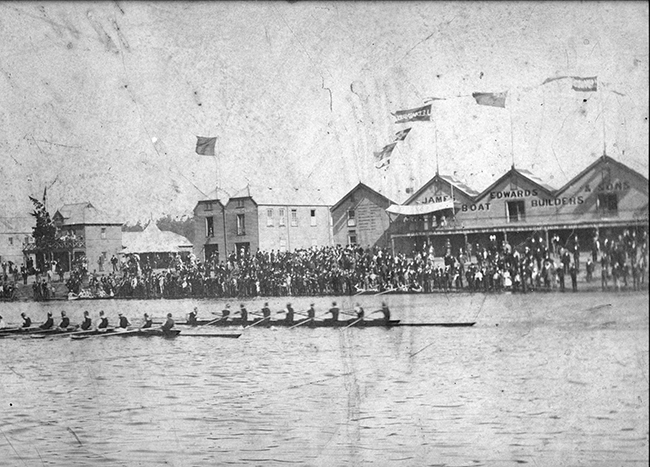
Race day in 1890
Photo from the Lindblade collection - Mercantile Rowing Club
The meeting also clarified membership requirements, reminding all club members that they are considered members of the Association, with clubs required to pay a portion of their subscriptions promptly. The election of officials saw the reappointment of key leaders, including president Mr. Henry Gyles Turner and several vice-presidents, who were commended for their dedication to amateur rowing. New committee members were also elected for varying terms, reflecting strong support for leadership continuity.
Anticipation for the upcoming championship races in fours (October 25) and sculls (Prince of Wales' Birthday) was high, with clubs actively training and supporters closely following their progress. The Banks Club Four, coached by Mr. Oxlade, was well-prepared and poised for strong competition. Meanwhile, Melbourne's crew, though training consistently, lacked a dedicated coach, which was believed to potentially hinder their performance. Yarra Club focused on longer downstream rows, though concerns were raised about their stroke technique and endurance over the three-mile race. Albert Park’s crew, coached by the veteran Gowdie, faced some disruption due to football commitments but remained determined to prepare adequately. The Barwon Club also trained in Geelong, though little information was available about their efforts.
The sculling championship was set to attract significant attention, with notable competitors such as Mr. G. C. Eastes from Sydney's Leichardt Rowing Club and Australian champion J. G. Kennedy expected to participate. Among the Victorian scullers, J. C. Fitzgerald led the charge with rigorous training, while Bannister, Gilbert, and F. Prior of Sandhurst were also preparing to compete.
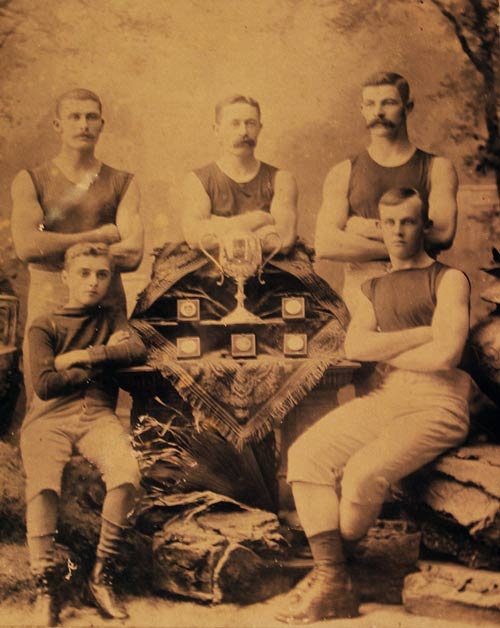
The winning Yarra Yarra Rowing Club Champion Four
Back row: 2: J Yeomans, 3: Alex Chamley, Str: Edward R Ainley, Front row: V G Petherick and Charles W Horsburgh
Photo courtesy Yarra Yarra Rowing Club
The first meeting of the new committee was scheduled at Young and Jackson’s, with the appointment of a new Hon. Treasurer to replace Mr. Upward being a key agenda item. Special thanks were extended to Mr. Upward and other key officeholders for their contributions to advancing amateur rowing.
Overall, the 1890 season reflected a vibrant rowing community with strong leadership, dedicated club efforts, and growing public interest in competitive events. However, challenges such as declining regatta receipts, uneven coaching resources, and club commitments to other sports were evident. Despite this, the enthusiasm and preparation demonstrated by the clubs and individual rowers underscored a shared determination to uphold the sport’s competitive and amateur ideals.
Championships (conducted during the calendar year 1890)
Winner | Other competitors | Time | |
Men's Champion Scull | J C Fitzgerald, Melbourne City
| 2nd William Lambert, Mercantile (NSW), 3rd J L Bannister, Corio Bay, 4th J B Walters, Yarra Yarra, 5th G Browne, Melbourne City, 6th P Bradley, Melbourne City, 7th A F Garrard, Barwon | 21 mins 10 secs |
Men's Four | Yarra Yarra – Bow: Charles W Horsburgh, 2: J Yeomans, 3: Alex Chamley, Str: Edward R Ainley, Cox: V G Petherick
| 2nd Banks, 3rd Albert Park, 4th Melbourne, 5th Barwon | 19 mins 30 secs |
Men's Eight | Banks – Bow: C Poynter, 2: A Dench, 3: W H Hatch, 4: H M Hutchinson, 5: G K Harker, 6: C M Garrard, 7: F G Payne, Str: R B Nicolson, Cox: H C Edwards
| 2nd Yarra Yarra, 3rd Albert Park, 4th Williamstown | 17 mins 58 secs |
Intercolonial Championships
The Intercolonial Championships were conducted without the endorsement of the Victorian Rowing Association due to the dispute over amateur status. The Victorian crew was however a fully representative crew and the fund raising and organisation was led by George Upward and with the tacit approval of all involved in Victorian rowing.
The Championships were conducted in Brisbane for the first time and the Victorians were lucky to come away with a win. It was raced in rough conditions. Queensland started well taking the lead from the other two states. NSW was swamped half way through the race and withdrew. Victoria then started working their way through the Queensland lead but was repelled by Queensland who maintained a two length lead. About a quarter of a mile from the finish, Queensland was hit with a significant wash from a passing steamer and the two seat blade was snapped. To minimize the impact of carrying him, the two man jumped overboard. The Victorians made the best of the situation surviving the wash and passed the Queensland crew. The Victorian crew comprised: Bow: W Hatch, 2: C Poynter, 3: F G Payne, 4: Arthur G Jenkins, 5: F James, 6: William Watson, 7: Charles S Cunningham, Str: R B "Bob" Nicolson, Cox: V Petherick, Emerg: W Robb, Cch: Walter Bray
1890-91 season
The Victorian Rowing Association (VRA) held its 15th annual meeting at Young and Jackson’s Hotel on 28th September 1891, attracting a large and engaged audience. In the absence of the president, Mr. H. G. Turner, vice-president Mr. Thomas Ellison chaired the meeting. The annual report highlighted the year’s key developments, with financial and organisational achievements taking centre stage.
A significant event during the year was the devastating flood (still to this day the largest recorded flood of the Yarra, seeing the water rise 14-metres higher than normal) that caused extensive damage along the Yarra River. While the boathouses and boats near Prince's Bridge sustained minimal harm, the Boroondara Rowing Club at Hawthorn suffered catastrophic losses, losing their boathouse, boats, and other assets. The association expressed strong solidarity with Boroondara, encouraging all clubs to assist in their recovery efforts. Despite these challenges, the river remained a focal point for rowing, and the association worked to maintain its usability for competitions.
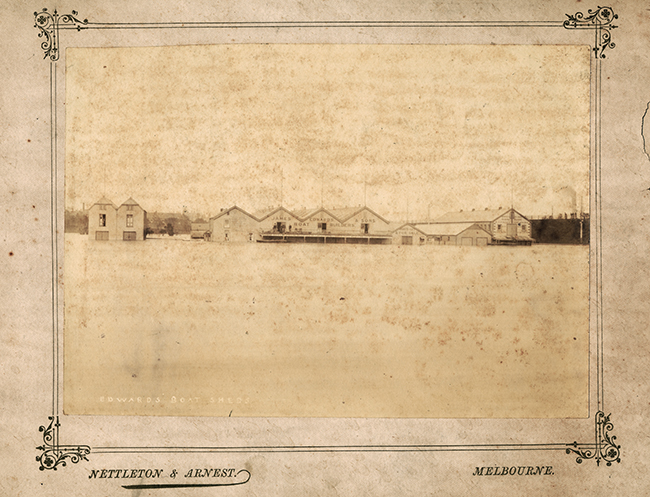
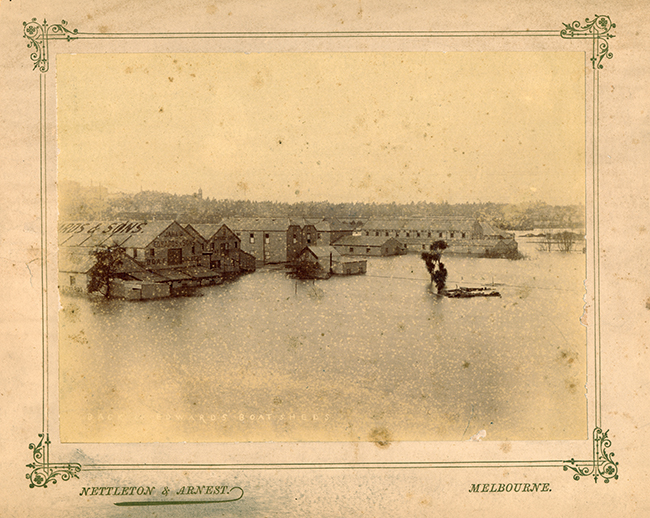
1891 floods showing the City boat sheds from the front and from the rear
Photos from the Lindblade collection - Mercantile Rowing Club
The association continued to demonstrate its competitive dominance, with the Victorian crew securing its sixth consecutive victory in the intercolonial eight-oared race. This achievement was widely celebrated as a testament to the strength of rowing in the state. The competitive calendar was robust, featuring events such as the Four-Oared Championship of Victoria (October 24), the Sculling Championship of Victoria (November 9), and the Claymore Trophy Eight-Oared Race (December 19). The season opened with a procession of boats on October 3, led by the Yarra Yarra Club, the reigning champions.
A notable topic of discussion was the potential establishment of intercolonial contests on amateur lines with South Australia and Tasmania. While collaboration with New South Wales was deemed unlikely due to disagreements over amateur status, enthusiasm for broader intercolonial competition was high. The initiative was expected to strengthen the camaraderie and competitiveness among amateur rowers across the colonies.
The election of office bearers saw the reappointment of the president and vice-presidents, alongside the election of new committee members from clubs across the region, ensuring broad representation. The contributions of secretary Mr. W. B. House were recognised with a vote of thanks, reflecting his ongoing dedication to advancing the association's objectives.
The 1891 season reflected a year of resilience and growth for the VRA. Despite natural disasters and external challenges, the association reinforced its position as the leading force in Australian rowing, with strong financial health, increasing membership, and continued competitive success. These accomplishments set a promising foundation for future seasons and reinforced the importance of collaboration within the rowing community.
Championships (conducted during the calendar year 1891)
Winner | Other competitors | Time | |
Men's Champion Scull | W J Bridson, Wellington (NZL)
| 2nd Edward R Ainley, Yarra Yarra, 3rd K Ritchie, Tamar (TAS), 4th R Gow, Tamar (TAS), 5th J McRae, Mercantile (NSW), 6th J B Sneider, Yarra Yarra, 7th J B Walters, Yarra Yarra | 20 mins 58 secs |
Men's Four | Yarra Yarra – Bow: Charles W Horsburgh, 2: J Yeomans, 3: Alex Chamley, Str: Edward R Ainley, Cox: V G Petherick
| 2nd Albert Park, 3rd Footscray, 4th Civil Service | 20 mins 40 secs |
Men's Eight | Yarra Yarra – Bow: James McDonald, 2: F Galvin, 3: Charles W Horsburgh, 4: Edward Horsburgh, 5: Arthur H Enticott, 6: James Yeomans, 7: Alex Chamley, Str: Edward R Ainley, Cox: V Petherick
| 2nd Banks, 3rd Corio Bay | 18 mins 0 secs |
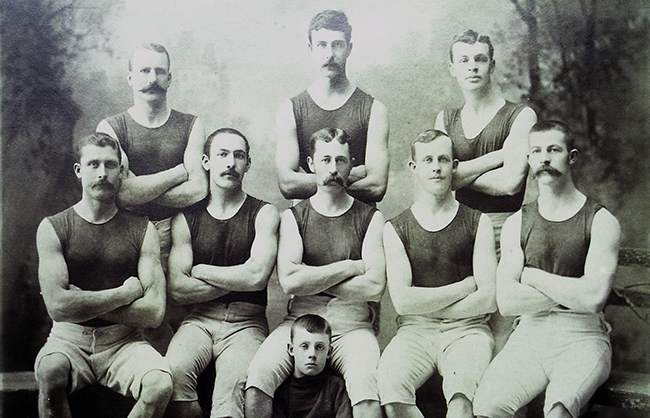
Champion Eight of Victoria from Yarra Yarra Rowing Club
Back row: F Galvin, Arthur Enticott, Edward 'Teddy' Horsburgh. Front row: James Yeoman, James McDonald, Edward Ainley, Charles Horsburgh, Alex Chamley, In front: G Horsburgh (who did not cox the 1891 crew). Photo from the Yarra Yarra Rowing Club collection.
Intercolonial Championships
The 1891 Championships were conducted on 28th November 1891 on the Lower Yarra River. Again it was not organised by the Victorian Rowing Association due the amateur definition dispute. George Upward and his committee organised the event and the Victorian crew selection and management.
After the disappointment of the previous year, the Queenslanders were determined to win. The Queenslanders suffered some set backs on the way to victory. The seven day sea journey from Brisbane was stormy and interferred with their condition. They had to make a late crew change due to V Jessop suffering from influenza. Finally their coaches were unable to travel. Despite these issues, they won handsomely for the first time. The Victorian crew was: Bow: W Hatch, 2: H Hutchinson, 3: B James, 4: W A Jones, 5: Arthur J Shepherd, 6: T Parkin, 7: A M Treacy, Str: F James, Cox: Vernon Petherick, Cch: George Upward.
1891-92 Season
The Victorian Rowing Association's (VRA) 1892 season marked another year of growth for amateur rowing in Victoria, with successful events, organisational achievements, and new challenges addressed. The season featured a variety of competitive races and initiatives that underscored the association’s commitment to the sport.
The VRA maintained its strong financial position, with total receipts of £269 7s. 8d. and expenditures of £226 12s., leaving a healthy surplus of £42 15s. 8d. The association’s careful financial management ensured stability, with no outstanding liabilities. Much of this success was attributed to the diligent efforts of Mr. W.B. House, the honorary secretary and treasurer, who was recognised for his outstanding contributions. Governance was further strengthened by the re-election of Mr. H.G. Turner as president and a slate of vice-presidents, including prominent figures such as Messrs. E.L. Zox and F. Stuart.
The 1892 season showcased a packed calendar of championship and club-level events. These included the Championship Four Race, Championship Sculling Race, and the Claymore Trophy Eight-oared Race, among others. These events demonstrated the growing enthusiasm for amateur rowing, with increased participation from Melbourne clubs and surrounding regions. The Championship Eight-oared Race and the intercolonial eight-oared race were particularly significant, drawing widespread attention and enthusiasm.
The association also focused on maintaining the popularity of rowing through strategic event planning. Discussions were held regarding the selection of regatta courses, with the Upper Yarra ultimately chosen for its accessibility and ability to attract larger crowds. This decision highlighted the association’s focus on both fairness in competition and efforts to popularise the sport.
Despite the successes, the season was not without its challenges. One of the key issues discussed was the financial burden of intercolonial races. A proposal to establish a separate fund for intercolonial race expenses, supported by contributions from all association members, was debated but ultimately withdrawn. Many clubs expressed concerns about their ability to afford additional levies, particularly given the economic strains of the time. Instead, members emphasised the need to reduce regatta losses and improve overall financial efficiency.
The formal opening of the 1892 rowing season featured a procession of boats led by the Yarra Yarra champion eight-oared crew. While the event was not as well-attended as the previous year, it underscored the community’s enthusiasm for the sport and the VRA’s efforts to foster camaraderie among clubs. Crews paraded from Princes Bridge to Richmond and performed manoeuvres in front of the boathouses, showcasing their skills and team spirit.
The 1892 season reinforced the VRA’s role as a leader in amateur rowing in Victoria. Strong governance, financial stability, and a vibrant calendar of events highlighted the association’s ongoing success. While challenges such as financial strain and course selection persisted, the season demonstrated the resilience and dedication of the rowing community. The VRA’s commitment to fostering the sport ensured that amateur rowing in Victoria continued to thrive, laying a strong foundation for future growth.
State Championships
Interstate Championships
The regatta was conducted for the first time in Queensland on the Brisbane River. This was the last Victorian crew selected by George Upward’s committee. It stood aside following the adoption of an amateur status definition at the intercolonial conference of 1888. The Queensland crew drew the worst station and combined this with a bad start to never be in the race. The Victorian and New South Wales crews had a great race. The winning Victorian crew comprised: bow: W H Hatch, 2: Arthur J Shepherd, 3: A H James, 4: D Christie, 5: F J E James, 6: W A Adams, 7: J A Brotherton, Str: R B "Bob" Nicolson, Cox: A E Hobson, Cch: W Bray. The first semi regular Interstate Sculling Championship commenced at this regatta but Victoria was not represented. The race was won Slack of Queensland from Lambert from NSW.
1892-93 Season
The 1893 Victorian rowing season was marked by significant developments in competition, governance, and the financial resilience of the Victorian Rowing Association (VRA) during a challenging economic period.
The seventeenth annual meeting of the VRA was held at Young and Jackson's Hotel, with Vice-President Thos. Ellison chairing the session. The Chairman praised the meticulous report prepared by the outgoing and incoming secretaries, which detailed the association's activities and financial standing. Despite the economic downturn, the association remained financially stable, ending the year with a small credit balance and no outstanding liabilities. This achievement was seen as a testament to the dedicated work of the committee and,in particular, the long-serving honorary secretary, Mr. House, who announced his resignation after seven years of service. However, he agreed to continue in the role of treasurer.
The championship four-oared race saw strong competition, with the Yarra Yarra crew ultimately securing victory. This win was particularly notable as the championship had continued to grow in prestige, drawing participation from interstate crews, including a team from Tasmania, which was warmly welcomed. There was optimism that more colonies would participate in future editions of the race. Additionally, the champion sculler of the season, Mr. Slack, was widely praised as one of the finest scullers to have competed on the Yarra River, with even his competitors acknowledging his superior skill.
In the intercolonial races, Victoria faced stiff competition. The Victorian crew was defeated by New South Wales in the eight-oared event, a result that was accepted with good sportsmanship given Victoria's historically strong performances in this category. Despite the loss, confidence remained high that Victorian rowing would continue to be competitive at the intercolonial level.
The annual regatta faced financial difficulties, closing with a deficit despite the hard work of Mr. House and his team. In response, discussions were held regarding improvements to race organisation and dispute resolution, particularly for events held on the Saltwater River. New rules were proposed to address these issues, reflecting the association’s commitment to ensuring fair and efficient race management.
The season also saw an exceptionally fast time recorded in the eight-oared championship race by the Yarra Yarra crew, a performance believed to be the fastest recorded in any of the Australian colonies at the time. This achievement highlighted the high calibre of rowing talent in Victoria and reinforced the association’s reputation as a leading body in Australian rowing.
Additionally, discussions took place regarding a proposed Pan-Britannic Festival, an ambitious event aimed at showcasing rowing talent across the British Empire. Although the economic conditions of the colony were not conducive to immediate plans, the VRA was acknowledged as the preeminent rowing association to lead such an initiative should it come to fruition.
The elections saw the reappointment of key officials, including President H. G. Turner and Vice-Presidents Thos. Ellison, T. F. Morkham, E. L. Zox, Frank Stuart, G. E. Upward, and H. T. Jordan. Several committee members were re-elected, ensuring continuity in leadership.
Overall, the 1893 season was characterised by resilience in the face of economic challenges, a commitment to maintaining high competitive standards, and a vision for the future of Victorian and intercolonial rowing.
Footnotes
< previous Chapter 3
> next Chapter 5

